How many tables Waiters can serve depends on a lot of factors, such as the level of service expected and even the experience of the Waiter or Waitress.
In this article, we’ll break down the typical number of tables served in different types of restaurants and explain what factors influence table assignments.
How Many Tables Do Waiters Serve at a Time?
There’s no one-size-fits-all answer to this question. It varies based on the restaurant setting, customer expectations and the efficiency of the service team.
However, here’s a general idea of what to expect:
Casual and mid-range restaurants
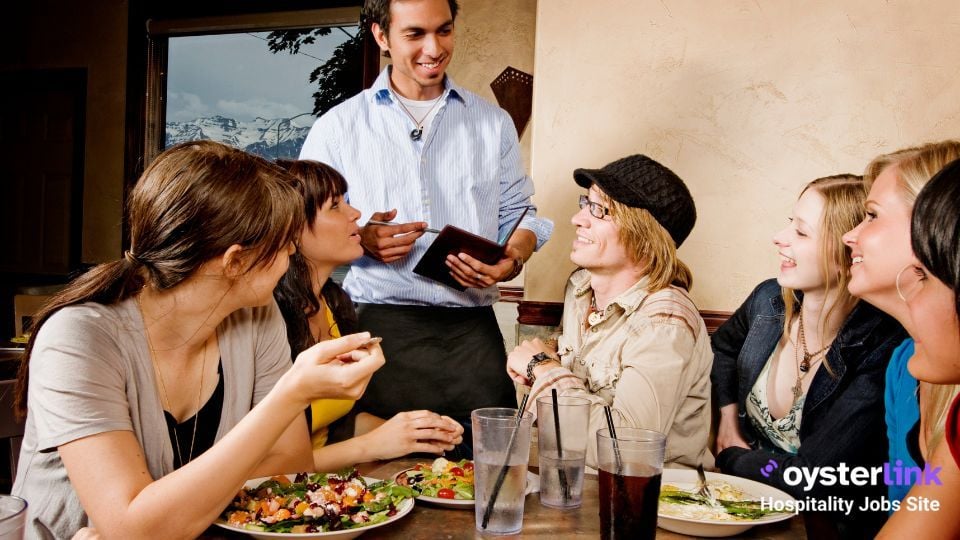
In casual dining establishments, Waiters/Waitresses typically handle four to six tables at a time.
These restaurants have a moderate pace — guests expect good service, but they aren’t looking for the highly detailed, tableside attention you’d find in fine dining.
Since the food is prepared fairly quickly and guests don’t linger for long, a well-organized Waiter or Waitress can manage multiple tables without feeling overwhelmed.
Fine dining restaurants

In high-end establishments, the service is much more detailed, and guests expect a refined experience.
Because of this, Waiters/Waitresses in fine dining typically handle two to four tables at a time.
With multiple courses, wine pairings and personalized service, there’s simply no way to juggle too many tables while maintaining the level of attention required.
Fast-paced diners and breakfast spots
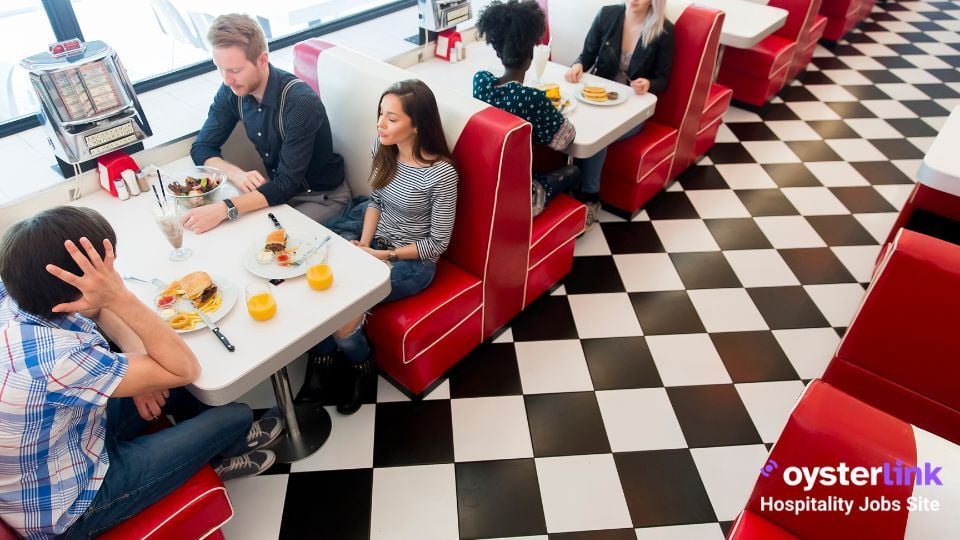
Diners, cafes and breakfast restaurants often have a six- to eight-table section per Waiter/Waitress. These places operate at a high speed, with guests coming and going quickly.
The menu items are often simpler and prepped fast, so Waiters and Waitresses rely on efficiency rather than extended tableside interaction.
Buffets and high-volume restaurants
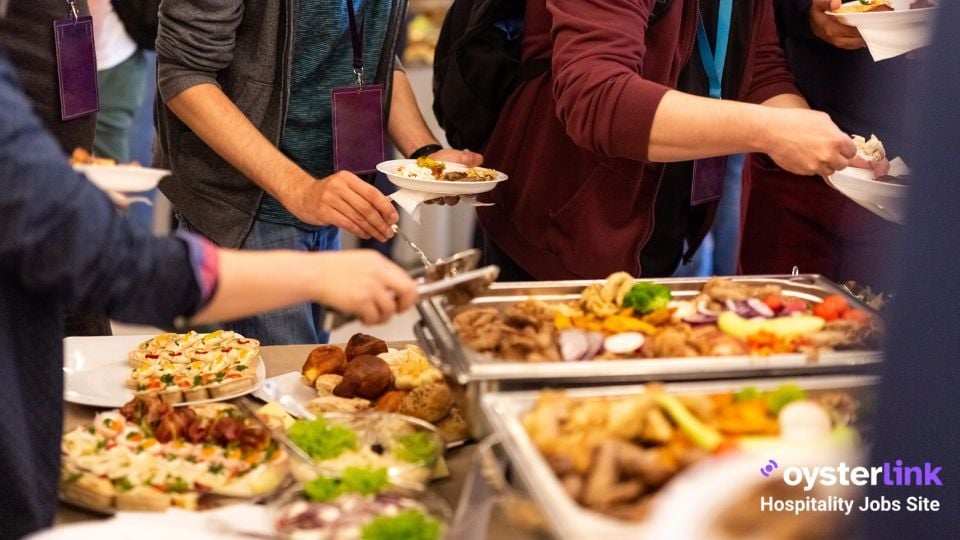
In buffets or restaurants with a self-service element, Waiters/Waitresses may be assigned 10 or more tables because their role is primarily to clear plates, take drink orders and restock supplies.
Since guests serve themselves most of their meals, the service workload is much lighter compared to a full-service restaurant.

Factors That Affect How Many Tables Waiters Serve at a Time
As previously mentioned, how many tables a Waiter or Waitress can handle isn’t set in stone.
It varies from one restaurant to another and depends on a combination of the following factors:
- Restaurant type: Fine dining requires more attention, leading to fewer tables per Waiter compared to casual spots.
- Staffing and size: More support staff (Food Runners, Bussers) means Waiters can manage more tables; fewer staff means fewer tables.
- Turnover rate: Quick turnover venues assign more tables, while places with longer stays, like steakhouses, have fewer per waiter.
- Experience level: New waitstaff handle 2-4 tables; experienced ones manage 6–8 in casual environments.
- Technology and support: POS systems and team-based models enable Waiters to manage more tables efficiently.
- Type of restaurant: A fine dining restaurant that serves multi-course meals with wine service requires more attention than a casual burger joint. The more complex the service, the fewer tables a Waiter or Waitress can effectively manage.
How Do Waiters Manage Multiple Tables at Once?
Waiting multiple tables involves more than taking orders and delivering food — it’s a balancing act that requires timing, organization and strong communication skills.
Here’s how Waiters and Waitresses stay on top of their respective sections:
Prioritization and timing
Good Waiters and Waitresses develop a sense of timing: knowing when to check on a table, when to drop the check and when to step back and let guests enjoy their meal.
They learn to prioritize tasks based on urgency, such as taking a new table’s order before refilling drinks at another table.
Efficient walking routes
Rather than making unnecessary trips, experienced Waiters and Waitresses consolidate tasks — grabbing multiple drink refills, pre-bussing a table while dropping off food or checking in with several tables in one round.
Memory and note-taking
Some waiters and waitresses have incredible memory skills.
However, even those who don’t rely on memory use small tricks — like using shorthand when writing orders or mentally grouping tables together — to keep track of guest requests.
Multitasking without rushing
Waiters and Waitresses need to move fast but not make guests feel rushed.
A skilled Waiter can take an order at one table while acknowledging another guest with eye contact or a quick, “I’ll be right with you!”
Communication with the kitchen and bar
Strong communication between Waiters/Waitresses, the kitchen and the bar ensures orders come out on time and guests aren’t left waiting.
Waiters and Waitresses who build a good rapport with Chefs and Bartenders often get their orders prioritized, keeping service running smoothly.
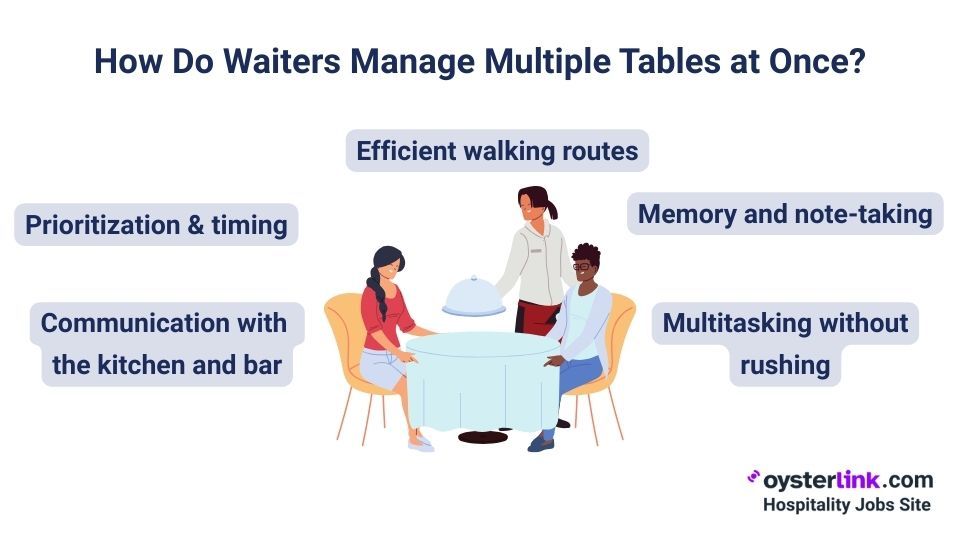
How Many Waiters/Waitresses Does a Restaurant Need?
For Restaurant Managers and owners, understanding how many Waiters/Waitresses to schedule is key to maintaining good service without overstaffing.
Several factors come into play when determining the right number of Waiters and Waitresses for a shift. Here are some things to consider:
- Industry rule of thumb: One Waiter per 4–6 tables in casual dining; One per 2–3 in fine dining, varies by layout and peak hours.
- Busy nights vs. slow shifts: Fewer staff on slow shifts, more during busy dinner rushes; strategic floor planning ensures coverage.
- Using reservation data and sales forecasting: Many restaurants track sales and reservations to predict staffing; overstaffing reduces tips, understaffing harms service.
Find Staffing and Job Opportunities With OysterLink
In most cases, Waiters and Waitresses typically handle four to six tables in a casual setting, two to four in fine dining and six to eight in fast-paced environments.
However, factors like experience, staffing and technology can significantly impact how many tables a Waiter or Waitress can manage efficiently.
If you’re thinking about becoming a Waiter, don’t worry if managing multiple tables seems intimidating at first — it’s a skill that improves with time and practice.
And if you’re a Restaurant Manager wondering how many Waiters or Waitresses to hire, the key is balancing efficiency with great customer service.
Looking for a restaurant job or hiring experienced Waiters/Waitresses? OysterLink can help!
Whether you’re an aspiring Waiter/Waitress or a restaurant in need of great staff, check out top-paying Waiter/Waitress jobs and expert insights into the hospitality industry.


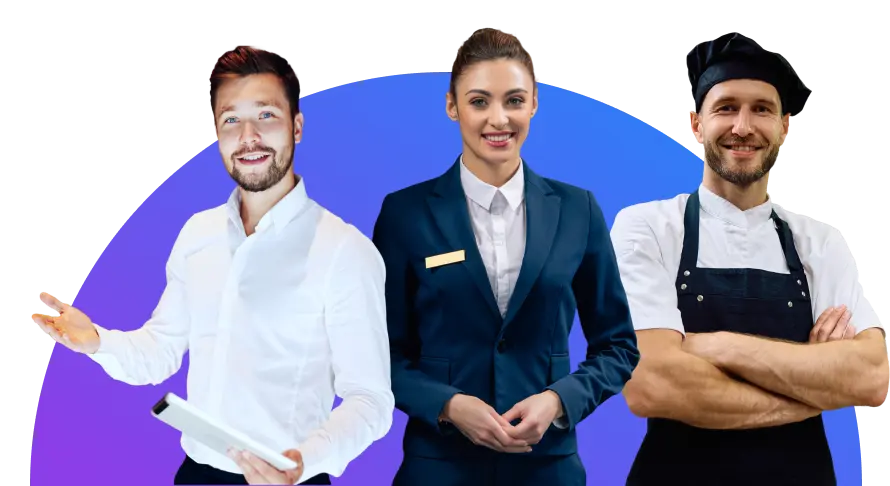







Loading comments...